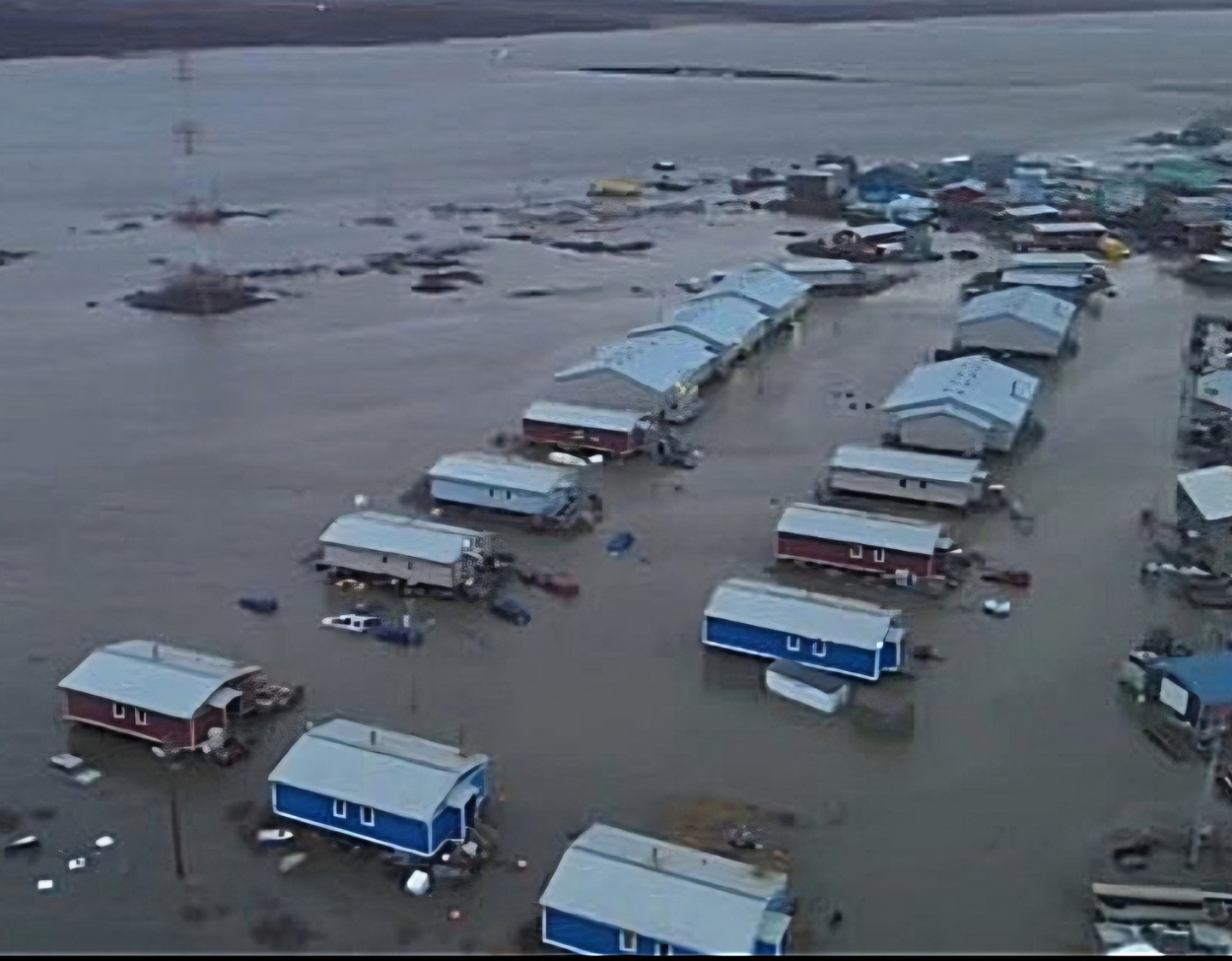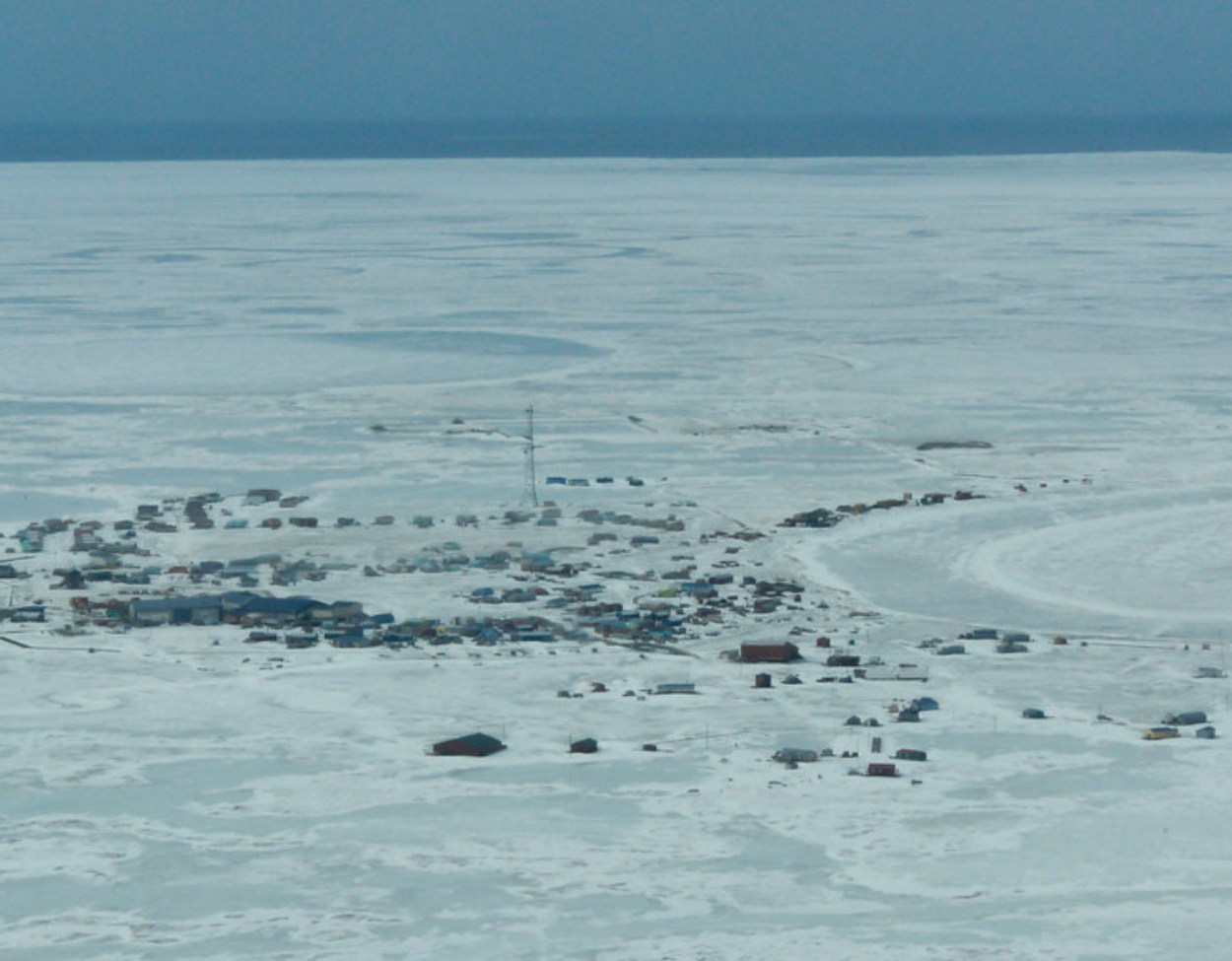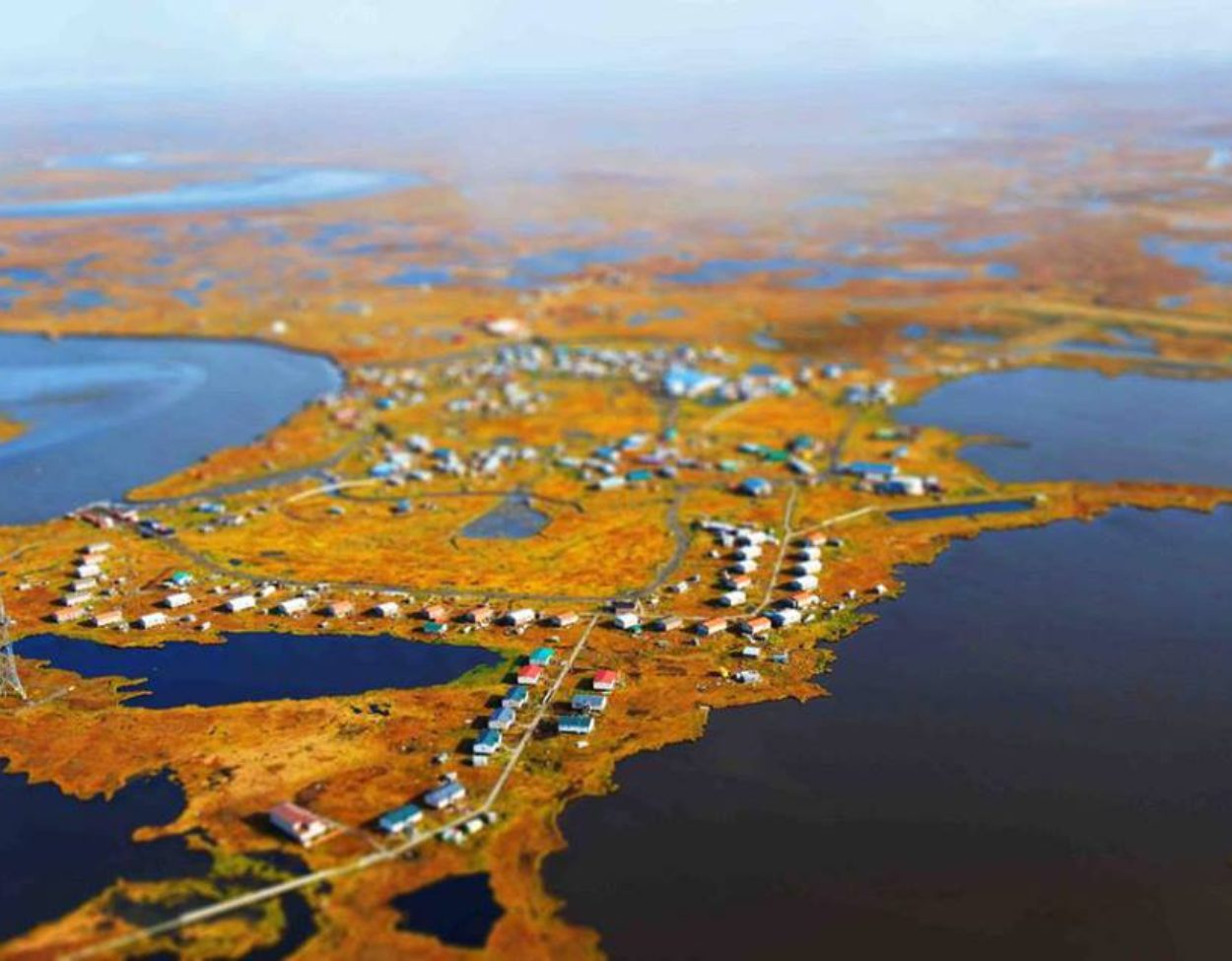October 17,2025.
August 18, 2025 Julia Tilton of the Yonder Reported that "Rural Communities, Tribes Sue EPA Over $2.8 Billion in Canceled Funding for Flood Mitigation and Resilience Projects.
The sudden withholding of federal funds poses an existential threat to projects that have been in the works for years in communities across the U.S.
A coalition of nonprofits, tribes, and local governments is suing the U.S. Environmental Protection Agency (EPA) over the termination of $2.8 billion in environmental and climate justice grants for disadvantaged communities.
One member of that coalition is located a few miles off the coast of the Bering Sea. The Native Village of Kipnuk (Qipneq), Alaska, is built on thawing permafrost. Qipneq means ‘bend’ in the Native Yup’ik language, referring to the village’s location along the meandering Kugkaktlik River.
In recent years, high water has become a common phenomenon in Kipnuk, as the riverbanks become destabilized by melting permafrost, flooding, and erosion. Stronger storms in the region exacerbate damage to the village’s infrastructure.
The Native Village of Kipnuk is a federally recognized Tribe with around 1,700 members, including about 800 members who live along the river in Kipnuk. The Tribe relies on the surrounding land for subsistence living, and historically, members moved around the region following a nomadic lifestyle. But after the government built a school along the Kugkaktlik River in the 1930s, many families moved to the village of Kipnuk.
Today, erosion rates along the riverbank are between 10–28 feet a year, according to Rayna Paul, the village’s environmental director. And despite a number of assessments having been conducted in Kipnuk by the state and federal government over the past 15 years, the Tribe has yet to see any action to protect their community from high water.
“There’s been so many assessments that our tribe is getting tired of them,” said Paul. “They just want some action done.”
Earlier this year, it appeared that action might be on the horizon. Kipnuk was awarded a $20 million Community Change Grant under a $3 billion program from the EPA to carry out environmental and climate justice projects across the country. That program made $2.8 billion available for direct financial assistance to communities, local governments, and tribes. Kipnuk would use the money to address erosion along a stretch of riverbank that houses the community’s critical infrastructure, including the wind turbines that generate power, fuel tanks, several buildings, and the boardwalk connecting them.
The award was finalized in early January 2025, and Kipnuk’s project start date was set for March 1 of 2025. When the funds were made available in early March, Paul hired a bookkeeper to keep track of grant spending and posted a job vacancy for a project manager. But a few days later, the project’s funding flow was turned off as part of President Donald Trump’s federal funding freeze. By May, the Trump administration had terminated the EPA’s environmental and climate justice grant program altogether.
Rayna Paul is the environmental director for the Native Village of Kipnuk, Alaska. Paul worked on the village’s EPA grant application in 2024 and had just begun work on the project in March when she received news of the grant’s cancellation. She has not been compensated for her time. (Courtesy of the Native Village of Kipnuk)
For Paul, who also worked to put together the grant application in 2024, receiving the termination letter less than two months into starting the project was a significant blow. Amidst frozen funds and the grant cancellation, Paul has still not been compensated for her time, including the months she put in leading up to the award. Relaying the news about the grant cancellation to the rest of the community has been “discouraging,” Paul said.
“Everyone I’ve spoken to was like, ‘Oh man, what are we gonna do now?’ Their hopes fell,” Paul said.
Since May, the Native Village of Kipnuk and more than twenty others who have had their grants canceled have signed onto a class action lawsuit against the EPA and the Trump-appointed administrator, Lee Zeldin. The lawsuit, which was filed on June 25, will be heard in the U.S. District Court of the District of Columbia on August 5.
Broken Promises
The town of Clinchco, Virginia, is at the heart of Dickenson County along the McClure River in the southwest corner of the state. It’s among a number of former coal camps in the region dealing with the economic impact of the coal industry’s decline: the town’s poverty rate was over 40% at the last U.S. Census. For the population of around 300, building resiliency is made more complicated by floodwaters from increasingly intense storms, including Hurricane Helene.
During a series of listening sessions over the past several months, Clinchco residents dreamed up a multifaceted approach to economic and disaster resilience. They envisioned a new green space along the McClure River that would mitigate flooding and serve as a local dog park. They also started designing a resiliency hub equipped with backup power and emergency supplies for shelter in times of need.
Clinchco is one of five rural communities in southwest Virginia included in a $500,000 grant to the nonprofit advocacy group Appalachian Voices, which hosted the listening sessions.
The grant money comes from the EPA’s now-canceled environmental and climate justice program, the same pool of funding as for the grant awarded to Kipnuk.
Appalachian Voices held more than a dozen listening sessions with residents across the region to plan community-level projects that would be paid for by the EPA grant. Clinchco had requested approximately $40,000 for start-up costs associated with engineering designs, surveys, and permitting to pursue the resiliency projects.
Like others in the region, those projects are now “dead in the water,” according to Tina Deel, Clinchco Clerk of Council.
“It’s just heartbreaking,” said Deel. Without the grant money, Clinchco cannot afford to build the green space and resiliency hub on its own. Appalachian Voices’ new economy program manager Emma Kelly said that even with the help of state and private funding, projects like the one in Clinchco have been set back years.
“It was a lot of effort to get this initial application in, and now that’s all gone, and there’s not a lot of time and energy left to do that again,” said Kelly. “This promise has been broken.”
In towns like Clinchco that voted heavily for Trump, Kelly described a “widespread sense of betrayal and confusion,” particularly among former coal miners and their families who had believed the administration would support their interests. Deel said that she and others in the town were shocked that the funding had been withdrawn. She said it’s not an action by the Trump administration that she or others support.
A Power of the Purse Argument
When the hearing begins on August 5, much of the plaintiffs’ case will rest on the separation of powers between the three branches of government. Under the U.S. Constitution, the plaintiffs will argue that the executive branch does not have the authority to make decisions over programs that have been authorized and funded by the legislative branch.
Hana Vizcarra is a senior attorney at Earthjustice, one of the firms representing plaintiffs in Appalachian Voices et al. v. EPA. She said plaintiffs will argue that the EPA, an agency under Trump’s executive branch, violated the legislative branch’s “power of the purse” by canceling its environmental and climate justice program, which Congress created in 2022 under the Inflation Reduction Act (IRA) and section 138 of the Clean Air Act.
“This administration is trying to take power it doesn’t have,” said Vizcarra.
Last month, a Maryland federal district court ruled on another lawsuit against the EPA concerning canceled environmental justice grants. Vizcarra said attorneys will cite that case, Green & Healthy Homes Initiatives, Inc., et al. v. EPA, in their briefing.
There, the court found that the federal government violated the law by canceling grants made to regional grantmaking organizations selected to administer smaller grants to tribes, local governments, and community-based organizations. The Green & Healthy Homes ruling, which has been appealed by the EPA, did not go so far as to mandate the reinstatement of canceled funding for the three grantees involved, but it did make clear that the EPA cannot lawfully cancel grants on the grounds that environmental justice isn’t a priority of the current administration.
Rebecca Kaduru is the president of the Institute for Sustainable Communities, a plaintiff in Appalachian Voices.
The Institute for Sustainable Communities was selected as a national grantmaker for a portfolio of community-level grants ranging from $75,000 to $350,000 under the environmental and climate justice program. Kaduru said she believes the Green & Healthy Homes ruling sets up her organization’s case because it re-establishes grantmakers in some regions while organizations in others, like hers, are facing grant cancellations.
“There’s no reason why some Americans should have access and others not,” said Kaduru. “All Americans should have access to small grants for clean air and clean water.”
While there are similarities between the cases, Vizcarra stressed the two lawsuits differ in scope. Appalachian Voices is a class action lawsuit seeking a reinstatement of grant funding for all awardees impacted by the EPA’s cancellation of the environmental and climate justice program, not just the plaintiffs listed on the case.
The EPA filed a motion to dismiss the Appalachian Voices on July 14, arguing that the case is moot due to Congress’s recent passage of the One Big Beautiful Bill Act (OBBB). The EPA did not respond to the Daily Yonder’s request for comment for this story.
Attorney Ben Grillot with the Southern Environmental Law Center, which is also representing plaintiffs in the case, said the OBBB does not amend any laws, like the Clean Air Act, to retroactively bar money from being spent on environmental and climate justice projects.
“The big beautiful bill did not change that language. What it did do was rescind any unobligated funds, but all the grants that have been awarded are in fact still obligated,” said Grillot.
Of the $2.8 billion in funding initially available for the environmental and climate justice program, about $500 million has not yet been obligated. Approximately $2.3 billion has been obligated in the form of awards made to grantees across the country.
Among the plaintiffs living or working in rural communities, there are mixed emotions leading up to the August 5 hearing. While some are cautiously optimistic about the funding being restored, for others, the damage has already been done.
In Kipnuk, the construction season is limited by Alaska’s long winter. If funds were to turn back on after the hearing in August, the village would have about a month to begin working on the riverbank before having to pause until next spring. In the meantime, community members continue to grapple with the impacts of riverine erosion, thawing permafrost, and flooding from storms that can take up to an acre of land at a time.
When asked whether there was hope the funding would be restored after the court case, Tina Deel of Clinchco said, “We’re not holding our breaths.”
UPDATE: In the “A Power of the Purse Argument” section of the story, paragraph 4 was updated to accurately reflect the use of Green & Healthy Homes Initiatives, Inc., et al. v. EPA case as part of a briefing by the attorneys representing the plaintiffs.
Fast Forward to October 2025.
CNN and media across the US is reporting "1 killed, dozens rescued after storm slams western Alaska leaving thousands displaced.
Emergency responders in western Alaska are working to help more than a thousand residents displaced after ferocious, hurricane-force wind gusts from what once was Typhoon Halong tore through remote, coastal communities, unleashed record-breaking storm surge and shoved homes completely off their foundations.
At least one person, an adult woman, was found dead in the village of Kwigillingok, which has a population of less than 400, on Monday, the Alaska Division of Homeland Security and Emergency Management said in a statement.
Search efforts for two missing men from the same village have been called off after search and rescue crews found no sign of them, Alaska State Troopers spokesperson Austin Mc Daniels said in an update to the media Tuesday afternoon.
“We know this is devastating news for the families and loved ones of the two missing people,” Mc Daniels said. “If new evidence or credible information emerges about the location of the two individuals, we will immediately reassess that information and deploy appropriate resources to investigate and respond.”
Dozens of people and two dogs have been rescued in Kwigillingok and the nearby village of Kipnuk, which has about 700 residents, and more than 1,000 people were displaced to shelters, a local tribal health agency and state officials said Monday.
Dozens of evacuees have been moved to a shelter set up by the National Guard in Bethel, the largest city in western Alaska, but officials are considering moving residents to longer-term emergency housing in Fairbanks and Anchorage as they run out of space, the Associated Press reported.
Search and rescue efforts in the area involved helicopters rescuing people from the roofs of houses as they were surrounded by several feet of flooding, images reminiscent of rescues conducted during Hurricane Katrina, said US Coast Guard Capt. Christopher Culpepper.
“If you imagine the worst-case scenario, that’s what we are dealing with,” he said.
The sparsely populated villages are more than 400 miles southwest of Anchorage. “Both communities experienced strong winds and heavy flooding overnight, which caused significant damage, including at least eight homes being pushed from their foundations,” Alaska State Troopers said Sunday.
The region, particularly Kipnuk, is severely impacted, according to Mark Roberts, head of the State Emergency Operations Center.
“We are doing everything we can to continue to support that community,” Roberts said Tuesday afternoon. “But it is as bad as you can think.”
Officials are assessing how many properties in each village have been damaged, Roberts said, adding the number of people displaced in the area is large and changing rapidly.
As the storm approached the Alaska coastline late last week, forecast efforts may have been hampered by a lack of weather data triggered by the Trump administration’s cuts to federal agencies earlier this year. Following widespread layoffs at the National Weather Service, there has been a gap in weather balloon coverage in western Alaska. The balloons feed data directly into computer models used to forecast the weather.
However, there were few, if any, balloons to take measurements of what the weather was doing as the system approached Alaska.
Related article
U.S. Coast Guard MH-60 Jayhawk helicopter aircrews conduct overflights of Kipnuk, Alaska, after coastal flooding impacted several western Alaska communities, Oct. 12, 2025. The Coast Guard continues to support the state of Alaska’s response efforts in impacted communities. (U.S. Coast Guard photo courtesy of Air Station Kodiak)
Predictions for deadly Alaska storm may have suffered due to DOGE cuts
The storm generated wind gusts 100 mph or more in western Alaska on Sunday, akin to the gusts Category 1 or 2 hurricanes are capable of. Wind gusts hit 107 mph in Kusilvak while nearby Toksook Bay recorded a gust of 100 mph, according to the National Weather Service.
These winds also drove dangerous storm surge, pushing feet of water onto land, which triggered major flooding in coastal areas. Water levels in Kipnuk soared to 14.5 feet Sunday — more than 2 feet above major flood stage and 1.5 feet above the previous record flood level, set in 2000.
The storm was once Typhoon Halong, a powerful tropical system that formed in the northern Philippine Sea earlier this month, skirted Japan without making landfall and crossed the north Pacific Ocean. It was no longer tropical by the time it entered the Bering Sea this weekend, but that did not eliminate its power.
An aerial view shows flooding in Kipnuk, Alaska, on October 12.
An aerial view shows flooding in Kipnuk, Alaska, on October 12. Petty Officer 1st Class Shannon Kearney/US Coast Guard/DVIDS
The storm moved through northern Alaska late Sunday and pushed into the Arctic Sea early Monday, leaving communities to pick up the pieces in its wake.
“Every effort will be made to help those hit by this storm. Help is on the way,” Gov. Mike Dunleavy said in a statement Sunday announcing the expansion of a state disaster declaration to include the areas impacted by the weekend storm. He emphasized Monday there will be support for residents in the short term as well as for long-term needs.
Satellite imagery captures a powerful storm slamming into western Alaska this weekend.
Satellite imagery captures a powerful storm slamming into western Alaska this weekend. CSU-CIRA/RAMMB/NOAA
The initial declaration, issued Thursday, addressed damage in western Alaska caused by another powerful coastal storm earlier in the week that brought extensive flooding.
Sen. Dan Sullivan of Alaska said he has “been in frequent conversations with Acting FEMA Director David Richardson, and also in contact with local, tribal and state officials, including the Governor, and with Homeland Security Secretary Kristi Noem.”
“FEMA is in direct contact with state and local officials and has an incident management team traveling to Alaska as we speak with a FEMA search-and-rescue group pre-positioned in Washington on standby. According to FEMA, the government shutdown is not impacting the agency’s response to this emergency,” Sullivan said in a statement."
The residents have been airlifted out of the Native Village of Kipnuk. It is estimated by the State of Alaska that it will be at least 18 months before they can return.


Photo Credits: Picture directly above is before the flood. Photo credit Meteorologist Eric Graves. Photos by Jacqui Lang and Norma Andrea Evan in the aftermath of ex-Typhoon. Summer Photo prior to flood "Yonder".



